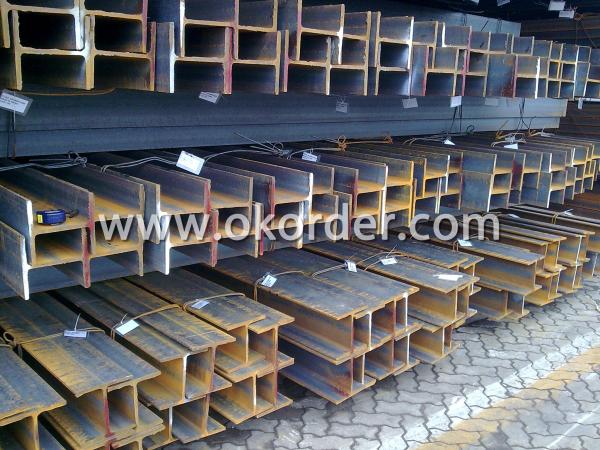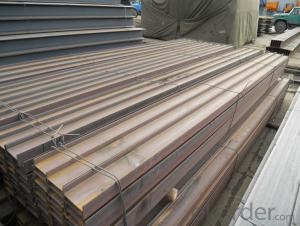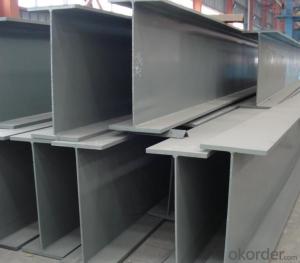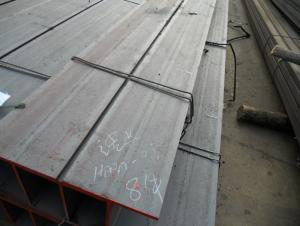Hot Rolled Steel H-beam
- Loading Port:
- China Main Port
- Payment Terms:
- TT or LC
- Min Order Qty:
- 100MT m.t.
- Supply Capability:
- 10000MT/MONTH m.t./month
OKorder Service Pledge
OKorder Financial Service
You Might Also Like
Specifications of Hot Rolled Steel H-beam For Sale
1. Standard: JIS
2. Grade: SS400
3. Length: 10m
4. Invoicing on theoretical weight or actual weight as customer request
5.Payment: TT or L/C
6. Sizes:
H x B
(mm)
| T1 | T2 | JIS Weight
(kg/m)
| GB Weight
(kg/m)
|
100*100 | 6 | 8 | 16.9 | 17.2 |
125*125 | 6.5 | 9 | 23.6 | 23.8 |
150*75 | 5 | 7 | 14 | 14.3 |
148*100 | 6 | 9 | 20.7 | 21.4 |
150*150 | 7 | 10 | 31.1 | 31.9 |
175*90 | 5 | 8 | 18 | 18.2 |
175*175 | 7.5 | 11 | 40.4 | 40.4 |
198*99 | 4.5 | 7 | 17.8 | 18.5 |
200*100 | 5.5 | 8 | 20.9 | 21.7 |
194*150 | 6 | 9 | 29.9 | 31.2 |
200*200 | 8 | 12 | 49.9 | 50.5 |
248*124 | 5 | 8 | 25.1 | 25.8 |
250*125 | 6 | 9 | 29 | 29.7 |
244*175 | 7 | 11 | 43.6 | 44.1 |
250*250 | 9 | 14 | 71.8 | 72.4 |
298*149 | 5.5 | 8 | 32 | 32.6 |
298*201 | 9 | 14 | 65.4 |
|
300*150 | 6.5 | 9 | 36.7 | 37.3 |
294*200 | 8 | 12 | 55.8 | 57.3 |
300*300 | 10 | 15 | 93 | 94.5 |
346*174 | 6 | 9 | 41.2 | 41.8 |
350*175 | 7 | 11 | 49.4 | 50 |
340*250 | 9 | 14 | 78.1 | 79.7 |
350*350 | 12 | 19 | 135 | 137 |
400*200 | 8 | 13 | 65.4 | 66 |
390*300 | 10 | 16 | 105 | 107 |
400*400 | 13 | 21 | 172 | 172 |
446*199 | 8 | 12 | 65.1 | 66.7 |
450*200 | 9 | 14 | 77.9 | 79.5 |
440*300 | 11 | 18 | 121 | 124 |
496*199 | 9 | 14 | 77.9 | 79.5 |
500*200 | 10 | 16 | 88.2 | 89.6 |
488*300 | 11 | 18 | 125 | 129 |
596*199 | 10 | 15 | 92.5 | 95.1 |
600*200 | 11 | 17 | 103.4 | 106 |
588*300 | 12 | 20 | 147 | 151 |
700*300 | 13 | 24 | 182 | 185 |
800*300 | 14 | 26 | 207 | 210 |
900*300 | 16 | 28 | 240.1 | 243 |
Usage & Applications of Hot Rolled Steel H-beam For Sale
Commercial building structure ;Pre-engineered buildings; Machinery support structure; Prefabricated structure; Medium scale bridges; Ship-building structure.etc.
Packaging & Delivery of Hot Rolled Steel H-beam For Sale
1. Packing: it is nude packed in bundles by steel wire rod
2. Bundle weight: not more than 3.5MT for bulk vessel; less than 3 MT for container load
3. Marks:
Color marking: There will be color marking on both end of the bundle for the cargo delivered by bulk vessel. That makes it easily to distinguish at the destination port.
Tag mark: there will be tag mark tied up on the bundles. The information usually including supplier logo and name, product name, made in China, shipping marks and other information request by the customer.
If loading by container the marking is not needed, but we will prepare it as customer request.
4. Transportation: the goods are delivered by truck from mill to loading port, the maximum quantity can be loaded is around 40MTs by each truck. If the order quantity cannot reach the full truck loaded, the transportation cost per ton will be little higher than full load.
5. Delivered by container or bulk vessel
Production flow of Hot Rolled Steel H-beam For Sale
Material prepare (billet) —heat up—rough rolling—precision rolling—cooling—packing—storage and transportation


- Q:How do steel H-beams perform in high winds?
- Steel H-beams are known for their excellent performance in high winds. Due to their structural design, which features a wide flange and a vertical web, they offer superior strength and rigidity compared to other materials such as wood or concrete. This makes them highly resistant to wind forces and ensures their stability during extreme weather conditions. The H shape of the beams distributes the load evenly, minimizing the effects of wind-induced vibrations and reducing the risk of structural failure. Additionally, the vertical web of the beams provides added stiffness, which enhances their ability to withstand lateral forces caused by high winds. Moreover, steel H-beams can be designed and manufactured to meet specific wind load requirements, ensuring that they are suitable for various wind zones and regions with different wind speeds. This flexibility in design allows for the optimization of the beams' performance in high winds, making them a reliable choice for structures in areas prone to strong gusts or hurricanes. Furthermore, steel is a highly durable and corrosion-resistant material, making steel H-beams resistant to the long-term effects of wind exposure. This characteristic ensures their longevity and structural integrity, even in harsh wind conditions. In summary, steel H-beams perform exceptionally well in high winds due to their superior strength, rigidity, and load distribution characteristics. Their ability to withstand wind-induced forces, coupled with their durability, makes them a reliable choice for structures that need to withstand extreme weather conditions.
- Q:Can steel H-beams be used for seismic retrofitting?
- Indeed, seismic retrofitting can utilize steel H-beams effectively. Due to their remarkable strength and capacity to withstand seismic forces, steel H-beams are frequently employed in seismic retrofitting endeavors. These beams serve the purpose of providing structural support and reinforcement to existing buildings, thus enhancing their ability to resist earthquakes and other seismic activities. Steel H-beams can be employed in various ways, such as strengthening crucial connections, adding extra bracing, or substituting weakened or damaged structural elements. Moreover, they can also enhance the overall rigidity and stability of the building, thereby preventing or reducing potential damage during an earthquake. Ultimately, steel H-beams offer a versatile and efficient solution for seismic retrofitting projects.
- Q:How do steel H-beams contribute to the overall functionality of a building?
- Steel H-beams contribute significantly to the overall functionality of a building by providing structural support and stability. These beams are designed to withstand heavy loads and distribute weight evenly, allowing for larger open spaces and flexible floor plans. They also enhance the building's resistance to lateral forces such as wind and earthquakes, ensuring its safety and durability. Additionally, H-beams facilitate efficient construction as they can be easily fabricated and interconnected, saving time and costs.
- Q:Are steel H-beams available in different finishes or coatings?
- Steel H-beams come in a variety of finishes and coatings. The most commonly used finishes or coatings for steel H-beams are galvanized, primed, and painted. Galvanized H-beams are coated with a layer of zinc to protect against rust and corrosion. This finish is perfect for outdoor or high-moisture settings. Primed H-beams are coated with a layer of primer, which creates a smooth surface for painting. This finish allows for customization with different paint colors and is often used indoors. Painted H-beams are coated with a layer of paint, providing both protection against corrosion and a visually pleasing appearance. Different paint colors can be chosen to match the desired design or style. Furthermore, there are specialized coatings available for steel H-beams, such as fire-resistant or anti-slip coatings, which cater to specific requirements or safety concerns in certain applications. In summary, the availability of different finishes or coatings for steel H-beams allows for customization and guarantees their durability and longevity in various environments.
- Q:Are steel H-beams recyclable?
- Yes, steel H-beams are recyclable. Steel is a highly recyclable material, and H-beams can be melted down and reused to manufacture new steel products, reducing waste and conserving resources.
- Q:Are steel H-beams resistant to pests or termites?
- Yes, steel H-beams are highly resistant to pests and termites due to their material composition.
- Q:What are the cost implications of using steel H-beams?
- Various factors can affect the cost implications of using steel H-beams. Firstly, the overall project budget can be significantly impacted by the cost of the beams themselves. Steel is a popular construction material due to its strength and durability, but it tends to be more expensive compared to materials like wood or concrete. The price of steel H-beams is influenced by market demand, supply chain dynamics, and global economic conditions. The size and dimensions of the H-beams also play a role in determining their cost. Larger and heavier beams generally require more steel material and may require specialized handling and transportation, making them more expensive. Moreover, the cost implications of using steel H-beams go beyond just the material. Other factors that need to be considered include fabrication, installation, and maintenance expenses. Fabrication costs involve cutting, welding, and shaping the steel beams to meet the project's specifications. Installation costs include labor, equipment, and any necessary support structures. Ongoing maintenance costs should also be taken into account, as steel requires periodic inspections, painting, and potential repairs for longevity. However, it is important to consider the long-term benefits of using steel H-beams. Their high strength-to-weight ratio and durability make them a reliable choice for structural applications. Steel H-beams have a longer lifespan compared to other materials, reducing the need for frequent replacements or repairs. This can result in long-term cost savings, as the initial investment in steel H-beams can offset the expenses associated with maintenance and replacement in the future. Ultimately, the cost implications of using steel H-beams should be analyzed in the context of specific project requirements, budget constraints, and long-term considerations. Seeking advice from professionals in the construction industry, such as engineers or contractors, can provide a more accurate assessment of the cost implications and assist in making informed decisions.
- Q:What are the considerations when designing for corrosion protection of Steel H-Beams?
- When it comes to designing for corrosion protection of Steel H-Beams, there are several crucial factors that must be taken into account. These factors include: 1. Environmental conditions: The environment in which the H-Beams will be situated is the first consideration. Factors such as humidity, temperature, and exposure to chemicals or corrosive substances need to be carefully considered. Different environments may necessitate different strategies for corrosion protection. 2. Corrosion resistance: The selection of material and surface finish for the H-Beams plays a vital role in corrosion protection. Typically, steel beams are coated with a protective layer such as galvanized coating, epoxy coating, or a paint system. The choice of the appropriate coating must consider the expected lifespan of the structure and the severity of the corrosive environment. 3. Maintenance requirements: Regular maintenance is essential to preserve the corrosion protection of steel H-Beams. This includes inspections, cleaning, and reapplication of protective coatings as necessary. The design should facilitate easy access to all areas of the beams for maintenance purposes. 4. Design details: Specific design details can impact the corrosion protection of H-Beams. For instance, sharp edges or crevices can trap moisture and speed up corrosion. Therefore, it is important to design smooth, rounded edges and eliminate any potential moisture traps. 5. Compatibility with other materials: If the H-Beams come into contact with other materials such as concrete or dissimilar metals, galvanic corrosion may occur. Therefore, it is crucial to consider the compatibility of different materials and take appropriate measures to prevent galvanic corrosion, such as using insulating materials or coatings. 6. Ventilation and drainage: Proper ventilation and drainage are vital in preventing the accumulation of moisture and reducing the risk of corrosion. Designing the structure to allow for adequate airflow and incorporating drainage systems can help minimize the chances of corrosion. 7. Structural design considerations: The corrosion protection design should not compromise the structural integrity of the H-Beams. The additional weight of coatings or protective systems must be taken into account in the structural calculations to ensure that the beams can still bear the intended loads. In conclusion, designing for corrosion protection of Steel H-Beams entails careful consideration of environmental conditions, corrosion resistance, maintenance requirements, design details, compatibility with other materials, ventilation and drainage, and structural design considerations. By addressing these factors, the longevity and durability of the H-Beams can be maximized, reducing the risk of corrosion and ensuring the overall structural integrity of the system.
- Q:Can steel H-beams be used for agricultural storage buildings?
- Agricultural storage buildings can indeed utilize steel H-beams. These beams are widely employed in construction due to their durability and strength. They offer exceptional support and load-bearing capabilities, making them an ideal choice for storing heavy agricultural products, machinery, or equipment. Moreover, steel H-beams possess resistance against pests, fire, and adverse weather conditions, rendering them a reliable option for agricultural storage buildings. Nevertheless, it is crucial to consider various factors such as building size, design, local building codes, and specific requirements for the storage facility. Consulting a structural engineer or construction professional can ensure that the steel H-beams align with the precise needs and demands of the agricultural storage structure.
- Q:What are the requirements for steel H-beams in seismic zones?
- Steel H-beams in seismic zones need to meet specific requirements in order to ensure their structural stability and resistance to earthquakes. These requirements aim to minimize the risk of collapse or significant damage during seismic events. Some of the key requirements for steel H-beams in seismic zones are as follows: 1. Material Strength: H-beams should be made of steel with high tensile strength and excellent ductility to withstand the forces exerted during earthquakes. It is recommended to use high-strength low-alloy (HSLA) steel or structural steel with a minimum yield strength of 345 MPa (50 ksi). 2. Design Standards: H-beams in seismic zones must comply with specific design standards, such as the American Institute of Steel Construction (AISC) Seismic Provisions for Structural Steel Buildings or the Eurocode 8. These standards provide guidelines for the design, fabrication, and installation of H-beams to ensure their performance during seismic events. 3. Moment-Resisting Frames: H-beams in seismic zones are often part of moment-resisting frames (MRFs), which are designed to resist lateral forces caused by earthquakes. The design and connection of H-beams in an MRF should enable them to effectively absorb and distribute seismic forces. 4. Connection Details: The connection details between H-beams and other structural members, such as columns and beams, are crucial in seismic zones. Connections should be designed to ensure sufficient strength, stiffness, and ductility, allowing for the transfer of seismic forces without failure. 5. Damping Devices: In some cases, additional damping devices may be necessary to reduce the response of steel H-beams to seismic forces. These devices, such as viscous dampers or friction dampers, dissipate energy and minimize the deformation and displacement of H-beams during earthquakes. 6. Quality Control: Strict quality control measures should be implemented during the fabrication, welding, and installation of steel H-beams in seismic zones. This includes ensuring proper welding techniques, inspecting welds for defects, and conducting non-destructive testing to verify the quality and integrity of the H-beams. It's important to note that the specific requirements for steel H-beams in seismic zones may vary depending on local building codes, regulations, and the level of seismic hazard in the area. Therefore, it is crucial to consult with structural engineers and adhere to the applicable codes and standards when designing and constructing steel H-beams in seismic zones.
1. Manufacturer Overview |
|
|---|---|
| Location | Tangshan, China |
| Year Established | 2007 |
| Annual Output Value | Above US$ 80 Million |
| Main Markets | Mid East; Southeast aisa; korea |
| Company Certifications | |
2. Manufacturer Certificates |
|
|---|---|
| a) Certification Name | |
| Range | |
| Reference | |
| Validity Period | |
3. Manufacturer Capability |
|
|---|---|
| a)Trade Capacity | |
| Nearest Port | Tianjin; |
| Export Percentage | 20% - 25% |
| No.of Employees in Trade Department | 11-15 People |
| Language Spoken: | English; Chinese |
| b)Factory Information | |
| Factory Size: | Above 75,000 square meters |
| No. of Production Lines | 1 |
| Contract Manufacturing | OEM Service Offered; |
| Product Price Range | Average |
Send your message to us
Hot Rolled Steel H-beam
- Loading Port:
- China Main Port
- Payment Terms:
- TT or LC
- Min Order Qty:
- 100MT m.t.
- Supply Capability:
- 10000MT/MONTH m.t./month
OKorder Service Pledge
OKorder Financial Service
Similar products
New products
Hot products
Hot Searches
Related keywords





























